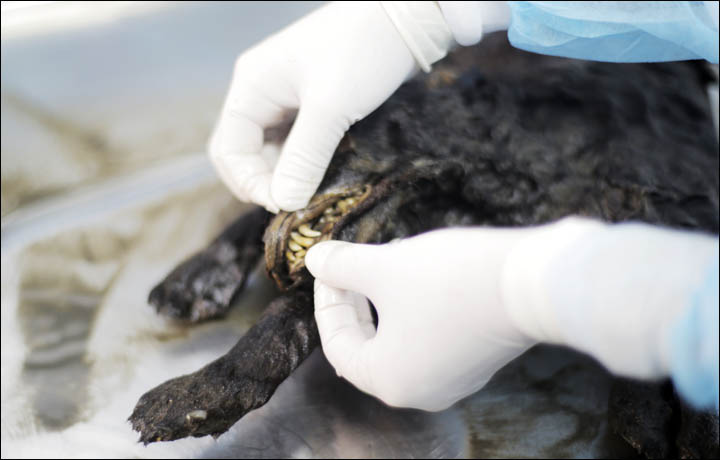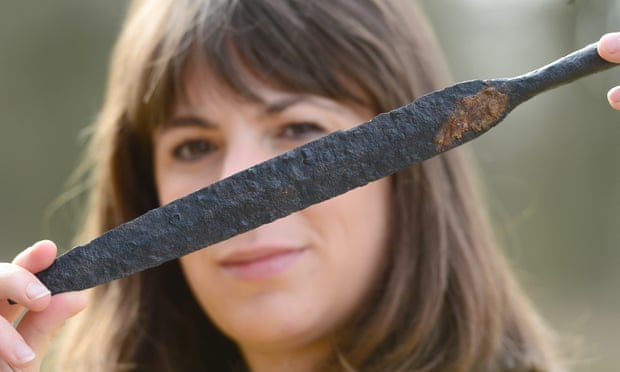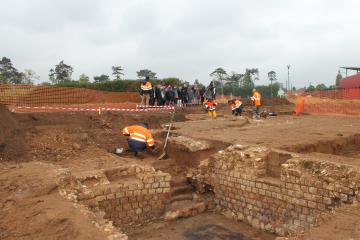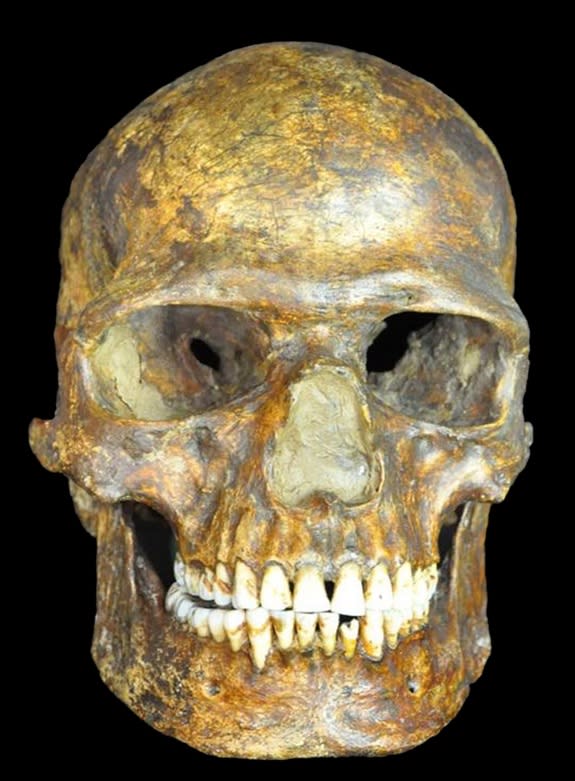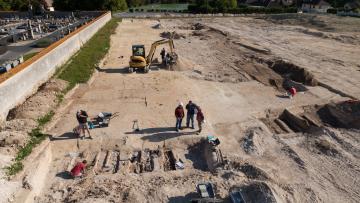The Prehistoric Archaeology Blog is concerned with news reports featuring Prehistoric period archaeology. If you wish to see news reports for general European archaeology, please go to The Archaeology of Europe Weblog.
Sunday, March 20, 2016
Ancient puppy's brain is 'well preserved'... as dog bares its teeth after 12,400 years
Scientists revealed today that they have found the first-ever well preserved brain of a Pleistocene canid. Our exclusive video and pictures show the autopsy on a carcass of a suspected pet puppy found mummified close to what are believed to be signs of human activity in the Ust-Yansky district of the Sakha Republic - also known as Yakutia - on a steep bank of the River Syalakh.
Present at the examination of the remains in regional capital Yakutsk was Hwang Woo-suk, the pioneering South Korean professor who is actively involved in seeking to clone woolly mammoths and other extinct creatures. The ancient dog is now added to the list of animals he wants to bring back to life.
Read the rest of this article...
Warrior king uncovered at east Yorkshire iron age settlement
The well-preserved remains were unearthed at a 2,500-year-old site in Pocklington, described as being of international significance
A spear head found at Pocklington. Photograph: Anna Gowthorpe/PA
A warrior king buried almost 2,500 years ago has been discovered in an iron-age settlement unearthed at the foot of the Yorkshire Wolds. The remains of the burial ground is being hailed as one of the largest and most significant iron age finds of recent times.
In 2014 a housing developer stumbled upon the fossil site in the small market town of Pocklington in east Yorkshire, a find that is said to be of extreme “national and international significance”.
One of the most exciting discoveries was the “remarkably” well-preserved remains of a youthful warrior. Found in the cemetery and dated to 800BC he had been ritually speared to “release his spirit” and lay in the ground next to his sword.
Read the rest of this article...
35,000-year-old carving of bird found in SW France
In advance of the construction of the eastern Bergerac bypass route (Dordogne), the preventive excavation realized by Inrap at the open-air doline site of Cantalouette revealed prehistoric occupations from the Middle Paleolithic and Neolithic periods. Iluminada Ortega and Laurence Bourguignon of Inrap, along with their Spanish colleagues, have announced in the Journal of Archaeological Science Reports, the discovery of an Aurignacian art object, 35,000 – 31,000 years old. This object, depicting a bird, contributes to our knowledge of the origins of figurative art. 35,000-year-old carving of bird found in SW France
The
bird engraving was found at the Aurignacian open-air site, Cantalouette
II (Dordogne, France) [Credit: © Iluminada Ortega, Joseba
Rios-Garaizar, Diego Garate Maidagan, Juan Arizaga, Laurence
Bourguignon. Denis Gliksman, Inrap]
This depiction is very distinct and probably unique in the Aurignacian period, during which Modern Humans arrived in western Europe. It is exceptional in its degree of naturalism, the nature of its support—the cortex (limestone coating) of a flint flake—and the engraving technique used. This “sunk relief” technique was identified through microscopic and 3D analyses realized at Cenieh (Burgos, Spain).
Read the rest of this article...
Tuesday, March 15, 2016
Ancient DNA identifies 'early Neanderthals'
The relationship of the Pit specimens to other ancient species has been the subject of debate
The oldest "nuclear DNA" from a human has identified some early representatives of the Neanderthal lineage.
They are about 400,000 years old, but their relationships to Neanderthals and other ancient relatives has been hotly debated.
DNA analysis confirms that they lie on the evolutionary line to Neanderthals.
The results are published in the journal Nature.
Read the rest of this article...
Archaeological dig planned as metal detectorist discovers untouched Bronze Age burial mound
Copper-alloy socketed chisel and fragment of a copper alloy dagger, found by metal detectorists at the site of the previously unknown Barrow, and dating to the Middle to Late Bronze Age
© Stuart Noon
Dig Ventures is planning its next crowd-funded archaeological dig following a major Bronze Barrow discovery by an amateur archaeologist
An untouched Bronze Age burial mound is a rare thing in the archaeological landscape of Britain, but in a sleepy corner of the North West a metal detectorist’s chance discovery is about to trigger a major dig that archaeologists hope will uncover more secrets of our pre-historic ancestors.
Archaeology crowdfunding platform, DigVentures, has launched a campaign to excavate the rare unexplored Bronze Age barrow in what will be the first scientific excavation of an undisturbed burial mound from the period in the region in over 50 years.
Archaeology crowdfunding platform, DigVentures, has launched a campaign to excavate the rare unexplored Bronze Age barrow in what will be the first scientific excavation of an undisturbed burial mound from the period in the region in over 50 years.
NEANDERTHALS: 20 PERCENT VEGETARIAN
The collagen from the Neanderthals’ bones offers clues to their diet. © Bocherens
Scientists from the Senckenberg Center for Human Evolution and Palaeoenvironment (HEP) in Tübingen have studied the Neanderthals’ diet. Based on the isotope composition in the collagen from the prehistoric humans’ bones, they were able to show that, while the Neanderthals’ diet consisted primarily of large plant eaters such at mammoths and rhinoceroses, it also included vegetarian food. The associated studies were recently published in the scientific journals “Journal of Human Evolution” and “Quaternary International.”
The paleo-diet is one of the new trends among nutrition-conscious people – but what exactly did the meal plan of our extinct ancestors include? “We have taken a detailed look at the Neanderthals’ diet,” explains Professor Dr. Hervé Bocherens of the Senckenberg Center for Human Evolution and Palaeoenvironment at the University of Tübingen, and he continues, “In the process, we were able to determine that the extinct relatives of today’s humans primarily fed on large herbivorous mammals such as mammoths and woolly rhinoceroses.”
Read the rest of this article...
Sunday, March 6, 2016
31 intact burials unearthed at large Mycenaean cemetery
An extensive Mycenaean cemetery with 31 undisturbed burials containing numerous items of jewellery and several different types of ceramic vases, including 12 ornate Mycenaean drinking cups or kylikes, has been unearthed by Greek archaeologists at the Loggas site near Elati in Kozani (Macedonia), a short distance from ancient Aiani. 31 intact burials unearthed in large Mycenaean cemetery
View of the excavation of the Mycenaean cemetery near Elati, Macedonia
[Credit: Georgia Karamitrou-Mentesidi via Ethnos]
"The Mycenaean presence in Upper Macedonia is now well established by the discovery of several settlement types throughout the region", says archaeologist Georgia Karamitrou-Mentesidi.
Read the rest of this article...
The images of chimps thrilled me: do they show evidence of spirituality in the wild?
A ritual with rocks observed in a study in Guinea has profound implications for our relationship with the animal kingdom
A young chimp collects rocks in a hollow tree trunk. Photograph: Kühl
A fter more than half a century of scientists studying chimpanzees in the wild, it was easy to think there were no surprises left. But there it was, right before our eyes – a new behaviour in our biological next of kin. We were a group of six on a field mission in the Republic of Guinea, investigating all aspects of a previously unstudied chimp community. These chimps didn’t enjoy the comforts of a protected area, but instead eked out their existence in what little habitat was left between expanding farms and villages.
The day of the discovery began as any other, struggling through the thorny African savannah while swatting away the sweat bees thirsty for our perspiration. We were surveying the area, looking for signs of chimps. We came to a stop at a clearing in the bush. I was relieved. It gave me a chance to untangle the thorns caught in my hair. But why had we stopped?
Read the rest of this article...
Friday, March 4, 2016
Travailler aux champs : la panoplie agricole antique de Saint-Clément
Les archéologues de l’Inrap ont découvert une panoplie d’outils agricoles du IIIe siècle, dans la cave incendiée d’une ferme antique à Saint-Clément (Yonne). Fouillé à l’automne 2015, sur prescription de l’État (Drac Bourgogne), dans le cadre de l’aménagement d’un lotissement par Brennus habitat, le site a livré d’intéressants vestiges de l’âge du Bronze et une partie de villa antique dont est issu cet important lot de mobilier métallique. Ce corpus unique livre quantité de renseignements sur l’organisation et le fonctionnement des fermes gallo-romaines.
Read the rest of this article...
Stone-throwing chimps leave scientists stumped by ‘sacred shrine
Chimpanzees in the savannah of Guinea and the forests of Liberia have been captured picking up stones and throwing them at a tree as well as placing them gently at the base
Chimpanzees in Guinea and the forests
of Liberia have been observed picking up stones and throwing them at a
tree as well as placing them gently at the base - behaviour that
appeared to serve no purpose and could be evidence of "ritualistic
behaviour" in animals.
"What we saw on this camera was exhilarating – a large male chimp
approaches our mystery tree and pauses for a second. He then quickly
glances around, grabs a huge rock and flings it full force at the tree
trunk," said Laura Kehoe, PhD researcher at Humboldt University of Berlin.
Read the rest of this article...
Thursday, March 3, 2016
Neanderthals collected manganese dioxide to make fire
Manganese dioxide is abundant in nature, and owing to their colour, these oxides have been used as pigments since the Stone Age. Some of the cave paintings in Lascaux, France, for example, were produced with manganese-based pigments. In a series of compositional analyses, scientists from Leiden University and Delft University of Technology conclude that Neanderthals at Pech-de-l'Azé I in South Western France had a strikingly different use for this mineral 50,000 years ago.
During excavations at several Neanderthal sites in France large numbers of small black 'blocs' where found. The usual interpretation is that these chunks of 'manganese oxides' were used for their colouring properties in body decoration, potentially even for symbolic expression. However Neanderthals habitually used fire and if they needed black material for decoration, soot and charcoal were readily available, whereas manganese oxides would have necessitated a considerably higher investment in both time and energy to obtain.
Read the rest of this article...
Why Did Ancient Europeans Just Disappear 14,500 Years Ago?
The skull of a man who lived between 36,200 and 38,700 years ago in Kostenki in western Russia
Some of Europe's earliest inhabitants mysteriously vanished toward the end of the last ice age and were largely replaced by others, a new genetic analysis finds.
The finds come from an analysis of dozens of ancient fossil remains collected across Europe.
The genetic turnover was likely the result of a rapidly changing climate, which the earlier inhabitants of Europe couldn't adapt to quickly enough, said the study's co-author, Cosimo Posth, an archaeogenetics doctoral candidate at the University of Tübingen in Germany. [Top 10 Mysteries of the First Humans]
The temperature change around that time was "enormous compared to the climactic changes that are happening in our century," Posth told Live Science. "You have to imagine that also the environment changed pretty drastically."
Read the rest of this article...
More "Polish pyramids" - new discoveries of archaeologists
More than a dozen hitherto unknown monumental megalithic tombs, have been discovered near Dolice (Western Pomerania) by archaeologists from Szczecin. They are so-called Kujawy tombs, often referred to as "Polish pyramids" because of their monumental character.
These ground structures were built in the shape of an elongated triangle and surrounded with huge stone blocks. The width of the base ranged from 6 to 15 meters and length reached 150 m. The structures reached a height of 3 m. The mounds usually contained single burials. Tombs were erected by the Funnel Beaker Culture community from the fifth to the third millennium BC According to archaeologists, people buried in these tombs were associated with the elders of the tribe and clan.
Read the rest of this article...
Wednesday, March 2, 2016
Le cimetière allemand de Boult-sur-Suippe
Une équipe de l’Inrap vient de fouiller un cimetière militaire allemand de la Grande Guerre. Ces recherches se sont déroulées en amont de la construction d’un lotissement par la société Immocoop et sur prescription de l’État (Drac Champagne-Ardenne). Environ 530 tombes et plus d’un millier d’objets personnels et militaires ont été mis au jour. Cette recherche d’ampleur permet notamment d’étudier la prise en charge des défunts et des blessés, du champ de bataille à la nécropole, et pour certains de les identifier.
Un cimetière de fortune
Durant les combats, dès 1916, les soldats ont été enterrés dans ce cimetière de fortune. Entre 1925 et 1927, période où les terres sont restituées aux agriculteurs pour relancer l’économie, une partie des sépultures est exhumée en urgence. Aujourd’hui, les archéologues mettent en évidence que les corps ont été partiellement prélevés, certains oubliés.L’étude portera sur le recrutement des soldats (âge, stature), leur état sanitaire, leurs provenances géographiques, les causes de leur décès, la chirurgie de guerre, la logistique militaire. Déjà figurent des recrues trop jeunes pour avoir eu l’âge légal de s’enrôler.
Read the rest of this article...
Glanzstück der Bronzezeit oder Fälschung?
Eine Tagung zur Goldscheibe von Moordorf
Der bronzezeitliche Goldschmuck aus dem bayrischen Bernstorf steht wegen der extrem hohen Reinheit des Metalls im Verdacht, gefälscht zu sein. In diesen Verdacht ist die gleichfalls bronzezeitliche Goldscheibe aus Moordorf (Ostfriesland) im Landesmuseum Hannover geraten, deren außergewöhnlich hoher Goldgehalt ebenso als Hinweis auf eine mögliche Fälschung gedeutet wird.
Read the rest of this article...
Subscribe to:
Posts (Atom)
